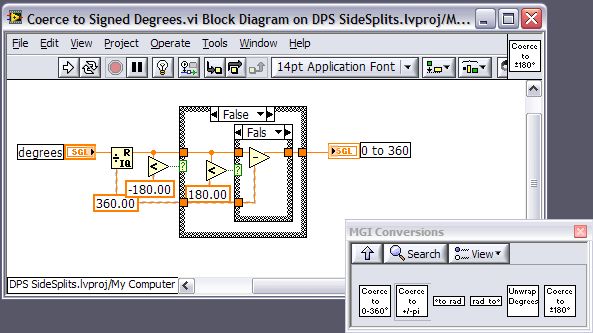-
Posts
752 -
Joined
-
Last visited
-
Days Won
2
Content Type
Profiles
Forums
Downloads
Gallery
Posts posted by Neville D
-
-
Can you upload some code?
I would try it first with remote panels instead of using a web browser. Its more robust. You can build a VI that calls up the front panels of remote running VI's. This will need the LV-RT engine installed on the "Host" PC.
You could build a TCP/shared variable communication protocol that runs the appropriate VI remotely (based on selected instrument) and then opens its front panel. I saw an example of this probably on the NI website or in the LV examples.
Re-entrant VI's or subpanel VI's might not update their panels correctly (search the help) especially in a web browser. I am not sure where the re entrant VI's are running..?
N.
-
I'm not sure why your comparing raw values. Why don't you use scaled values and compare those? Use a 1.5V battery connected to a channel and compare that with both codes. I'm sure it will read the same.
Raw DAQ values are only useful when you are doing extremely high-speed DAQ and you would rather scale the values post-data acquisition. For anything less than 1kHz sample rates its unnecessary.
N.
-
QUOTE (Aristos Queue @ May 22 2009, 01:42 PM)
Look at the online help for Obtain Queue. Search the help for the phrase "This function might return". Is this the sort of thing you're wanting to see on all functions?Exactly. That would help find other possible errors to deal with, when an error from a particular function pops up during debug.
Hmm.. never noticed that before. Is it a new addition? (Good work though!!)
Neville.
PS And while your at it, it would be nice to remove the explanation of the error in and error out clusters which are mostly unnecessary. A simple link to explain what they are would REALLY clean up the help functions, and help focus attention to other parameters which are always more important.
-
QUOTE (Tubi @ May 21 2009, 03:15 PM)
Well you can easily write a VI to stay within whatever bounds you desire +/-180 or +/-360.
Alternately, download the MGI freeware VI's using the VI Package Manager.
Install the MGI VI's then use Coerce to Signed Degrees.vi for +/-180 or Coerce degrees.vi for +/-360.
Found under following pallets: 7.x functions>MGI All VI's>MGI Numeric Tools>MGI Conversions.
But it might be quicker to write it yourself:
http://lavag.org/old_files/monthly_05_2009/post-2680-1243011626.jpg' target="_blank">

N.
-
You might try unloading all software components on the RT device that you don't need (for example VISA/DAQmx/Modbus IO Server/System State Publisher/WebServices Runtime/System State Publisher etc. ).
N.
-
QUOTE (rahul @ May 21 2009, 09:32 PM)
The cameras suddenly get undetected while the system is still running normally and then i have to just replug it (NO RESTART OR BOOT REQUIRED)Seems to me you have a bad cable/connector on the card. Try a new better quality cable. I have multiple firewire cameras on PXI-RT running for many months at a time 24-7 acquiring 500,000+ images without needing to reboot. I reboot them once in a while when I visit the customer-site or when uploading new software.
I have had problems with cheapo cables from the electronics store. More expensive cables are usually more reliable.
I use Prosilica cameras by the way.
Neville.
-
QUOTE (angel_22 @ May 21 2009, 01:52 PM)
In that case, you better read http://www.catb.org/%7Eesr/faqs/smart-questions.html' rel='nofollow' target="_blank">this.
N.
-
QUOTE (bobfrat @ May 21 2009, 01:25 PM)
I took a look at the example and it works great when putting files onto the SD Card. However it doesn't list the files located on the FTP server. Instead i get this error... "226 Closing data connection. Listing Complete." This message comes up as soon as I run the program but it still lets me put files onto the server. Has anyone seen this before?Thanks,
Bob
226 is not an error. FTP VI's (for whatever reason) generate 226 when theyr'e done with a task. It works fine when I point it to my PXI-RT chassis, correctly listing all the files under the root folder. Try IP address under "machine".
Neville.
-
Why don't you take a look at the LabVIEW getting started manual and the examples?
-
After a reboot, can you see the cameras in NI-MAX? If you can, then your code should be able to see them too.
Display a code snippet showing what you are doing at camera initialisation. Maybe during reboot the camera looses power and firewire doesn't provide power until after windows starts up? Dunno. Try swapping the firewire card to another slot? Or try another card? They are cheap enough.
The fact that windows can't find them either is a bit suspicious.
Neville.
-
What hardware/LV version?
What is your code doing?
Have you tried with a simple VI?
Have you tried using the execution trace tool kit to see if you can narrow it down?
What happens after the memory spike? Freeze? Crash?
Neville.
-
So whats your question? Get the IMAQ package if you have to.
Take a look at this for future reference.
N.
-
I'm not sure what you mean but if you want to "unwrap" the phase so there are not discontinuities at +/-180 deg, search for Unwrap Phase.vi.
N.
-
LabVIEW>Help>Find Examples>Toolkits & Modules>Vision
N.
-
Take a look at the FTP Browser.vi from the NI Example Finder>addons>Internet
N.
-
-
Make sure the port is closed by the application using it (CVI/Hyperterminal whatever).
Make sure to initialise the port correctly before starting communication Port#, Baud rate/stop bits etc etc.
These are most likely the causes of garbage communication; there is likely NOTHING wrong with the com port itself.
Try another com port if you have two..
N.
-
There are a number of Hyperterminal-like interfaces using VISA and LabVIEW, written by various people. Scott Hannahs is one of them. Search around LAVA for other examples.
N.
-
Why don't you post a quick snapshot of what you mean?
There is no need to "initialize" an array in LV.
Using Local Variables of an array is a bad habit to get into. (Race conditions, calls to memory manager affect performance, creates unnecessary copies of data).
Maybe a quick look at the Getting Started with LV manual would help.
N.
-
A quick and dirty way would be to copy the matlab code into a mathscript node and run that (assuming you don't have any esoteric matlab function calls that are not supported by the mathscript node).
It might not be too fast, but should get you started quickly enough.
Neville.
-
QUOTE (rolfk @ May 12 2009, 12:10 AM)
Which makes it probably more like XP Embedded anyhow
I think the moral of the story is: it might make sense to spend $500 Canadian/US$350/xxxEuros or so up-front on a LV-RT licence when reliability is key. No more windows "auto-updates" and other junk. (And no more vision activation required!! wooohooo!!)
N.
-
QUOTE (amila @ May 12 2009, 05:58 AM)
I've tried the second suggestion: make a cluster for each edge. I have the results that I want. But the problem is how to save all of them in a file?You can't use the Express VI's to do anything but very simple tasks. Look at examples of writing data to file. You already have the strings, write a simple VI to put that stuff into a file.
You can also right-click and convert an ExpressVI to a regular VI to look at the code inside to see if you can modify/re-use any of it. But from the level of questions you are asking, that might just further confuse you.
I would look at the file write examples and go from there. Maybe you can write data line by line (within the loop) instead of collecting it outside the loop and writing everything at once. But the file header (column names) would have to be written prior to loop start.
N.
-
Set up your software to plot the max number of channels (64) then hide the unwanted channels by plotting "NaN" for the unwanted channels (Not a Number, obtained by simply typing in NaN in the DBL constant).
N.
-



Remote panel not working in Subpanel
in Hardware
Posted
OK, your requirements are fairly complex and will not be solved by simple remote panels or web browser interfaces considering re-entrancy/panel size/display requirements.
Design a protocol to talk to each instrument. Display commands sent and responses recieved in separate tabs on your HOST or control PC. That way you have complete freedom to setup and run the instrument without the complexities of panel size etc.
You can use shared variables to simplify the communication protocol.
Check out:
Command based architecture (you can replace TCP-IP with Shared Variables to simplify; there are examples on the NI site using SV's instead of TCP-IP)
Advanced LV-RT resources (you can read up stuff here and apply to your LV-based targets as well).
Neville.